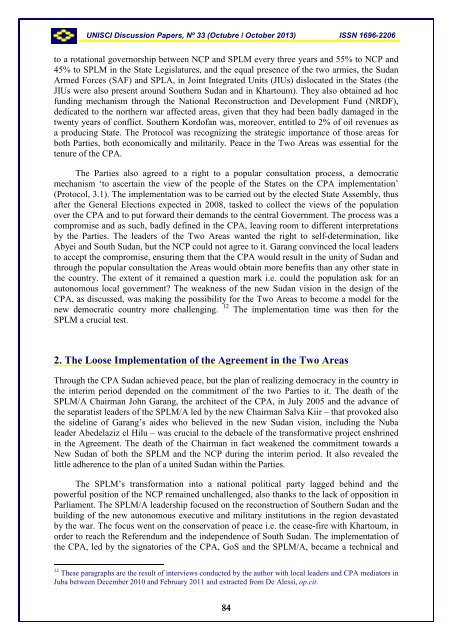UNISCI - Universidad Complutense de Madrid
UNISCI - Universidad Complutense de Madrid
UNISCI - Universidad Complutense de Madrid
You also want an ePaper? Increase the reach of your titles
YUMPU automatically turns print PDFs into web optimized ePapers that Google loves.
<strong>UNISCI</strong> Discussion Papers, Nº 33 (Octubre / October 2013) ISSN 1696-2206to a rotational governorship between NCP and SPLM every three years and 55% to NCP and45% to SPLM in the State Legislatures, and the equal presence of the two armies, the SudanArmed Forces (SAF) and SPLA, in Joint Integrated Units (JIUs) dislocated in the States (theJIUs were also present around Southern Sudan and in Khartoum). They also obtained ad hocfunding mechanism through the National Reconstruction and Development Fund (NRDF),<strong>de</strong>dicated to the northern war affected areas, given that they had been badly damaged in thetwenty years of conflict. Southern Kordofan was, moreover, entitled to 2% of oil revenues asa producing State. The Protocol was recognizing the strategic importance of those areas forboth Parties, both economically and militarily. Peace in the Two Areas was essential for thetenure of the CPA.The Parties also agreed to a right to a popular consultation process, a <strong>de</strong>mocraticmechanism ‘to ascertain the view of the people of the States on the CPA implementation’(Protocol, 3.1). The implementation was to be carried out by the elected State Assembly, thusafter the General Elections expected in 2008, tasked to collect the views of the populationover the CPA and to put forward their <strong>de</strong>mands to the central Government. The process was acompromise and as such, badly <strong>de</strong>fined in the CPA, leaving room to different interpretationsby the Parties. The lea<strong>de</strong>rs of the Two Areas wanted the right to self-<strong>de</strong>termination, likeAbyei and South Sudan, but the NCP could not agree to it. Garang convinced the local lea<strong>de</strong>rsto accept the compromise, ensuring them that the CPA would result in the unity of Sudan andthrough the popular consultation the Areas would obtain more benefits than any other state inthe country. The extent of it remained a question mark i.e. could the population ask for anautonomous local government? The weakness of the new Sudan vision in the <strong>de</strong>sign of theCPA, as discussed, was making the possibility for the Two Areas to become a mo<strong>de</strong>l for thenew <strong>de</strong>mocratic country more challenging. 12 The implementation time was then for theSPLM a crucial test.2. The Loose Implementation of the Agreement in the Two AreasThrough the CPA Sudan achieved peace, but the plan of realizing <strong>de</strong>mocracy in the country inthe interim period <strong>de</strong>pen<strong>de</strong>d on the commitment of the two Parties to it. The <strong>de</strong>ath of theSPLM/A Chairman John Garang, the architect of the CPA, in July 2005 and the advance ofthe separatist lea<strong>de</strong>rs of the SPLM/A led by the new Chairman Salva Kiir – that provoked alsothe si<strong>de</strong>line of Garang’s ai<strong>de</strong>s who believed in the new Sudan vision, including the Nubalea<strong>de</strong>r Abe<strong>de</strong>laziz el Hilu – was crucial to the <strong>de</strong>bacle of the transformative project enshrinedin the Agreement. The <strong>de</strong>ath of the Chairman in fact weakened the commitment towards aNew Sudan of both the SPLM and the NCP during the interim period. It also revealed thelittle adherence to the plan of a united Sudan within the Parties.The SPLM’s transformation into a national political party lagged behind and thepowerful position of the NCP remained unchallenged, also thanks to the lack of opposition inParliament. The SPLM/A lea<strong>de</strong>rship focused on the reconstruction of Southern Sudan and thebuilding of the new autonomous executive and military institutions in the region <strong>de</strong>vastatedby the war. The focus went on the conservation of peace i.e. the cease-fire with Khartoum, inor<strong>de</strong>r to reach the Referendum and the in<strong>de</strong>pen<strong>de</strong>nce of South Sudan. The implementation ofthe CPA, led by the signatories of the CPA, GoS and the SPLM/A, became a technical and12 These paragraphs are the result of interviews conducted by the author with local lea<strong>de</strong>rs and CPA mediators inJuba between December 2010 and February 2011 and extracted from De Alessi, op.cit.84
















